Issues with your dog’s paw(s) can occur for a number of reasons. Dogs can suffer wounds, issues with their nails, or cause trauma by chewing on their feet.
Continue reading for eight of the most common dog paw problems, what these problems look like, and what you can do.

The 8 Common Dog Paw Problems
1. Chewing the Paws
Dogs chewing, licking, or “grooming” their paws are some of the most common complaints veterinarians hear. Many owners believe that their dog is licking or chewing their paws due to anxiety or that they are just grooming themselves like cats. However, most of the time, dogs are chewing and licking their paws because they’re itchy!
Itchy paws and lower legs are common signs of environmental allergies. Your dog is touching all of that pollen, grass, different weeds, and dust with their feet all day long. The allergens in the environment that cause humans to have a stuffy nose cause your dog’s feet to itch like crazy.
- What it Looks Like: Your dog obsessively licks and chews their feet at any opportunity. They may focus on just one or two feet or maybe all of them. Their feet are often soaked with saliva and red, and they may also become sore and swollen from the constant chewing.
- What to Do: Talk to your veterinarian about allergy medication for your dog. Most people want to try an over-the-counter antihistamine. While some can help temporarily, they are not a great long-term solution. Also, do not purchase any OTC medication without checking with your regular veterinarian, as some human allergy medications can kill your dog. Do not immediately assume your dog is allergic to their food, and change their diet. The most common allergens your dogs will be affected by are in the environment. While your veterinarian may recommend a long-term food change, getting your dog on a monthly or daily allergy medication will likely give them much more relief.
2. Yeast & Bacterial Infections
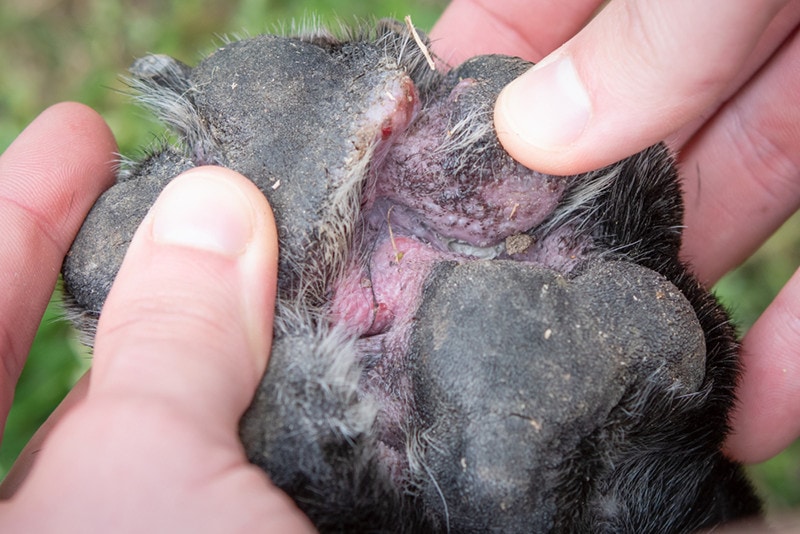
If your dog is suffering from allergies and chewing their paws, as discussed above, they are at risk of getting infections on their paws. Paw infections occur most commonly from self-trauma, such as your dog licking and chewing their feet. However, some dogs, such as Bulldog breeds, may suffer from paw infections from having excessive skin folds and other underlying skin issues.
- What it Looks Like: Your dog’s feet may often appear red and have a lot of moisture between the toes. This can occur on the top or bottom of the toes. Your dog’s nails, especially the nail beds, may be discolored and brown-colored, sometimes having a brown discharge. If bad enough, your dog’s paw or toes will become swollen, and you’ll see a purulent discharge (pus) between the toes.
- What to Do: Prevent your dog from continuing to chew and lick their paws by putting on an e-collar or placing a loose sock over their feet. This will allow you to get to your veterinarian for treatment. We do not recommend ointments or salves, as their gooeyness can cause more dirt, debris, bacteria, and yeast to stick to the surface of the feet. Also, do not tightly wrap your dog’s feet, which may cause them to swell and become more painful or infected. Your veterinarian will likely prescribe a combination of veterinary-friendly topical sprays, mousses, and oral medications.
3. Broken Nails
You know the drill—your dog is running like a banshee in the backyard, and they acutely scream and pick up a paw. Then, you find one of your dog’s toenails dangling. We commonly see broken nails in dogs who are hyperactive and constantly scratching at kennels, doors, and floors and digging in the dirt.
- What it Looks Like: Your dog’s nail can break anywhere from the tip all the way down to the nail bed (the portion of the nail next to the fur of the toe). Sometimes, your veterinarian can trim the broken part off. Other times, especially if the nail is broken near the base, your dog may need to be sedated in order for your veterinarian to remove the broken piece(s) safely. Inside each nail, a small blood vessel can bleed depending on where the nail is broken.
- What to Do: If your dog’s nail breaks, you can use clean flour or cornstarch over the bleeding area. Try to prevent your dog from licking at the nail by placing a loose sock over the foot or an e-collar. We then recommend taking your dog to the veterinarian to have them evaluate the break and trim the nails appropriately. Dogs can become very sensitive to broken nails, and even the nicest dog can bite their owner if they try to care for the broken nail at home. Your veterinarian may prescribe antibiotics and pain medications depending on how bad the broken nail is.
4. Overgrown Nails
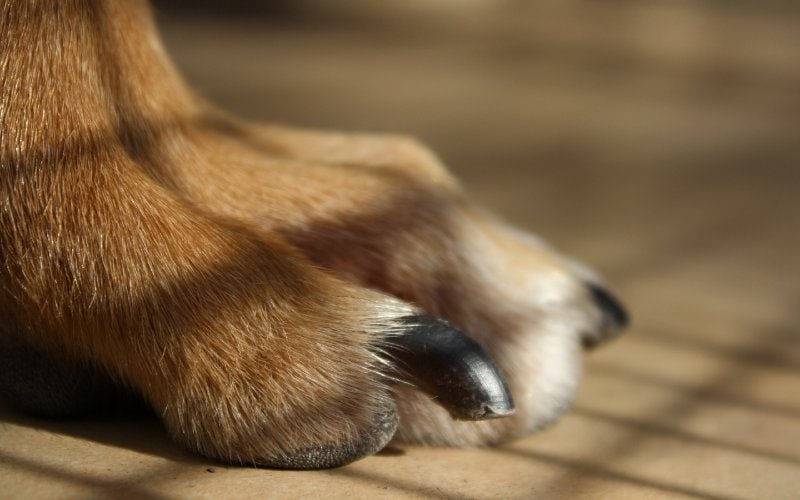
Older dogs who are fairly sedentary and who don’t like their feet touched may be prone to suffering overgrown nails. Remember that nails will continue to grow throughout a dog’s lifetime. No matter how old they are, their nails need to be regularly monitored and trimmed.
- What it Looks Like: Depending on your dog’s breed and size, overgrown nails may grow straight out and be very long. Others will grow straight out to a certain point and then start to curl under towards the pad. The longer the nails, the more difficult it will be for your dog to walk normally.
- What to Do: Take your dog to a professional groomer or to your veterinarian for a nail trim. Dogs often hate having their nails trimmed, and they may bite you if you attempt to do this by yourself at home. Also, a groomer or your veterinarian’s office will have the appropriate nail trimming tools, such as clippers or a dremel. Your dog should have their nails trimmed regularly—at minimum, a few times a year.
5. Wounds
Paws can be susceptible to many types of wounds, especially if your dog regularly walks or hikes in nature. Their paws can get cuts, scrapes, burs stuck in them, burns, and irritation. Always be mindful of the environment when you are walking your dog.
- What it Looks Like: Often, your dog will start to limp on one or multiple legs. You may notice drops of blood around the house or on the ground if there is a cut or abrasion on the paw. Never walk your dog on ice or anywhere that winter salt is used. This can be extremely irritating and painful to your dog’s feet. Also, be mindful of concrete, especially blacktops, in the sun. These surfaces can cause severe burns to your dog’s paw pads.
- What to Do: If your dog starts limping on a walk or while playing, don’t make them “walk it off.” Instead, stop the activity and see if they will let you look at each one of their feet. Make sure to check all the paw pads and in between all of the toes—top and bottom. If there are any wounds, bleeding, or discharge, you must take your dog to a veterinarian.
6. Toe Injury
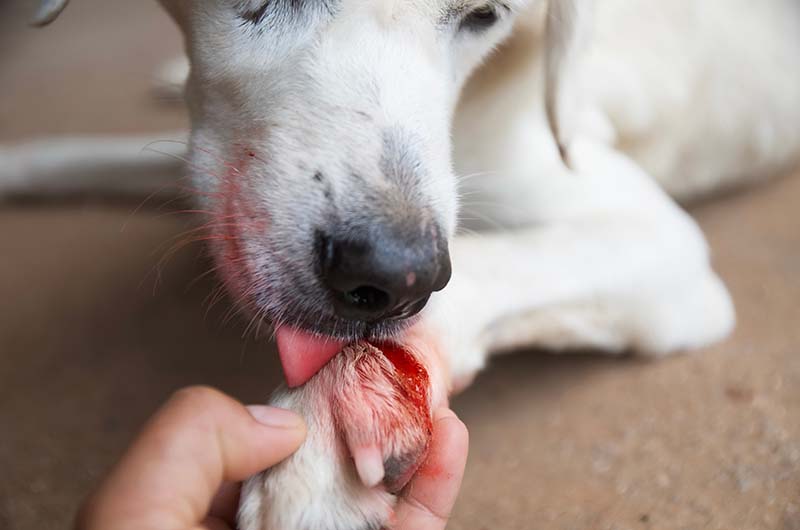
Similar to paw wounds, dogs can suddenly start limping if they have hurt one or multiple toes. This is fairly common with dogs who may have jumped off a height or who were playing or running and ran into something.
- What it Looks Like: You may not be able to tell your dog has a broken toe (or multiple). Sometimes, all you will notice is your dog limping. Other times, one or multiple toes may be swollen and painful to the touch. The worst-case scenario would be if the toe is at an abnormal angle.
- What to Do: If your dog starts to limp, you should stop their activity and let them rest. If the behavior continues throughout the day, make an appointment with your veterinarian. An X-ray is often needed to diagnose a broken toe or portions of the paw. As stated above, do not make your dog “walk it off.” Limping is a sign your dog is in pain, and you should allow them to stop walking! Also, do not administer any human pain medications since they can be toxic to your dog.
7. Growths
Lumps, bumps, and masses are common on your dog’s feet. These can be as small as a pinhead or as large as a lemon.
- What it Looks Like: Growths can sometimes appear as a skin tag, skin wart, or larger masses that grow from the underlying tissue or bone. They can appear anywhere on the paw, at any time, and at any age, though they appear more commonly in middle-aged to older dogs.
- What to Do: Seek your veterinarian’s advice. Unfortunately, benign growths and malignant growths can look like anything. Your veterinarian may want to sample the growth with a needle or schedule a biopsy to help diagnose it. Sometimes, it’s easiest to have your veterinarian surgically remove the mass and get a diagnosis after it’s taken off.
8. Matted Hair
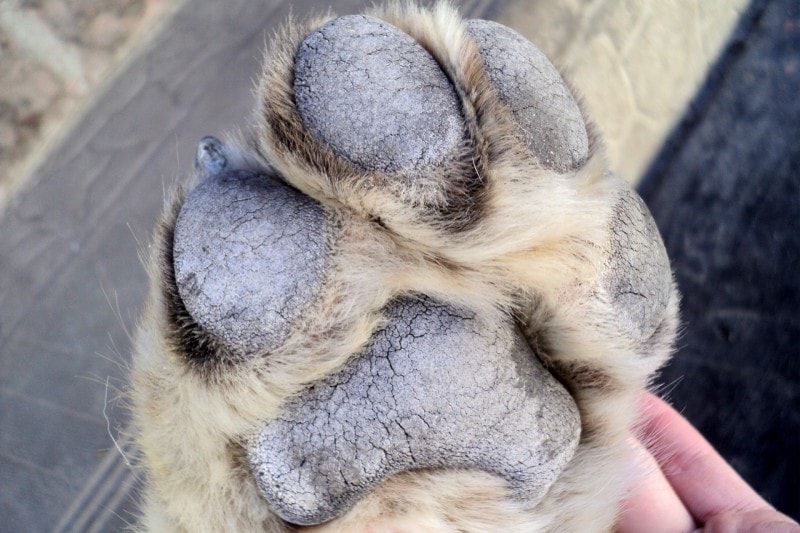
Long-haired dogs can be especially susceptible to matted hair anywhere on their body. Unfortunately, many owners may overlook their feet as an area for hair issues.
- What it Looks Like: Hair can become matted between the toes, especially on the bottoms of the feet. Long hair can also mat around the tops of the feet and the ankle areas. Once the hair starts to mat, debris such as feces, dirt, and sticks can also stick within the fur, making it worse.
- What to Do: Schedule your dog to have a grooming by a professional groomer ASAP. Do not attempt to cut the mats out of your dog’s hair at home with scissors. Dogs are often very wiggly, and many dogs have gone to the ER because their owners accidentally cut them with scissors. A professional groomer will have special tools to clip the mats safely and effectively. If your dog gets anxious when their feet are touched, you can ask your veterinarian to prescribe sedatives before their grooming appointment.

Conclusion
Dog paw problems are very common. Issues can range from matted hair to nail problems to wounds and itching. Each problem is unique and requires different treatments. With any type of paw problem, the best thing you can do is immediately stop your dog’s activity, make them rest, and look at their feet. Often, a trip to the veterinarian is your best bet, as they will have the medications and tools to treat the problem the best.
See also:
Featured Image Credit: Ivan Babydov, Pexels
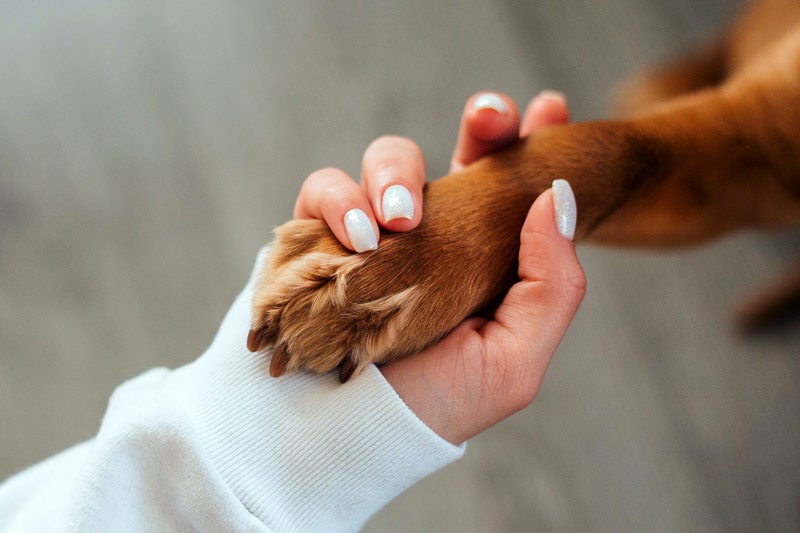


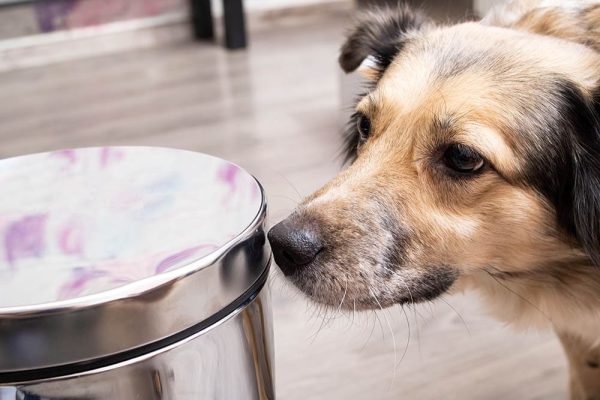

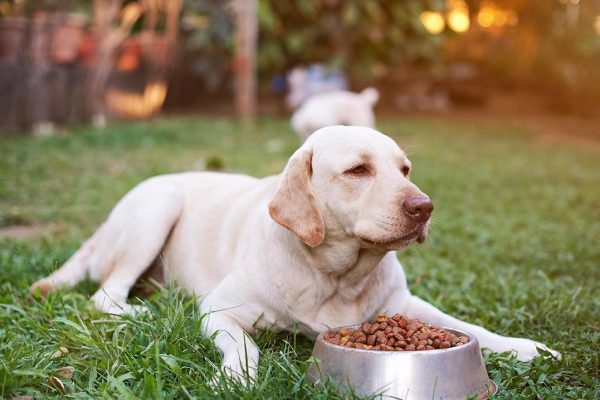






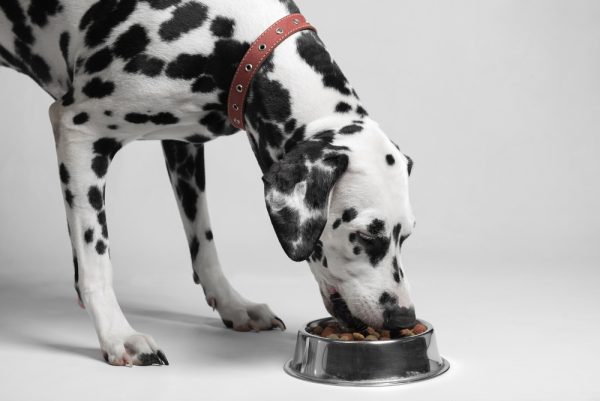






2 Responses
thanks but it is a big growth below his pads and is just hanging I am taking him to a different vet. The vet I was going to is only worry about making money and not the dog. he is 8 year old Havapoo
Hello Donna,
thank you for your comment. Sorry to hear about your dog's paw pad issues, though. If you would like to get a second opinion, we can recommend you booking an online video-call appointment with one of the professionals from www.PangoVet.com. In 20-minute call you can ask all the questions, and the vet will take a look at your pup and recommend you the next steps.
Hope your Havapoo will be alright!